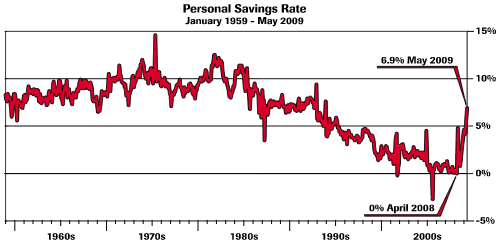2009 Q2 | The Sun Peeks Through the Clouds
 After reading William Cohan’s book “House of Cards,” I was taken aback by the level of greed that has tarnished respected financial institutions. Greed turned them into financial casinos where executive compensation levels became an overriding corporate objective. This excess is wrong and, just as the excesses of Drexel Burnham in the late 1980’s were corrected, today’s unwarranted and unnecessary compensation levels will eventually return to some form of sanity and normalcy.
After reading William Cohan’s book “House of Cards,” I was taken aback by the level of greed that has tarnished respected financial institutions. Greed turned them into financial casinos where executive compensation levels became an overriding corporate objective. This excess is wrong and, just as the excesses of Drexel Burnham in the late 1980’s were corrected, today’s unwarranted and unnecessary compensation levels will eventually return to some form of sanity and normalcy.
Greed was not restricted to the corporate suites of managements across the country. Unfortunately, more financial thievery was exposed this quarter as the public confidence in the U. S. financial markets had to withstand another indictment. Just as the Madoff case came to an end with a 150 year sentence, Mr. R. Allen Stanford, a Houston based financier, who operated significant offshore tax havens, was indicted. To our delight, the sheriff is here, and hopefully those that have abused the financial structure of our economy will be awarded a full measure of the prison sentences and fines they deserve. This is a precondition for restoring investor confidence, which should result in more normal equity valuations. “Normalcy” could equate to more than 50% above current stock prices. (See the Schopf Stop for more on this.)
With some investor confidence returning, and after six consecutive quarters of declining share prices, equities finally scored a respectable gain for the quarter ended June 30, 2009. The S&P 500 rose 15.2%, the NASDAQ increased 11.0% and the Dow Jones Industrial Average was up 11.9% for the quarter. This brought gains from the March lows to 35.9% for the S&P 500 and 44.6% for the NASDAQ. Year-to-date, the S&P is now up 1.8% and the NASDAQ is up 16.4%.
Although interest rates were volatile during the quarter, the bond markets were stable. The federal funds rate was unchanged in the quarter (maintaining the range of 0% – 0.25%), resulting in little movement in short-term rates. Long-term Treasury rates rose along the curve from two to thirty year maturities. A steep yield curve can be viewed as a good sign the economy is coming back to life. More importantly, spreads between government and corporate yields improved significantly, as credit fears that gripped corporate issuers eased materially in the quarter. Although far from normal, the improvement in credit spreads is encouraging, as it shows the credit crisis is moderating.
As the credit crisis moderates, there is some evidence of improvement in several key, leading economic indicators. The aforementioned interest rate spread between 10-year Treasury bonds and the federal funds rate is a healthy sign. Also, an increase in the money supply bodes well for future growth. Orders for durable goods posted their second straight monthly improvement in May. Finally, the sharp increase in stock prices from the March lows suggest that an expansion could be ahead. But although there are burgeoning signs of future growth, much of the economic data is still gloomy. The real Gross Domestic Product fell at a 5.5% rate in the first quarter of 2009. We anticipate a somewhat smaller decline in the second quarter. The unemployment rate, a lagging indicator, advanced to a twenty-year high of 9.5%. We expect further bad news on this front. In addition, auto, home and retail sales continue to struggle. We do expect some improvement in these areas as the year progresses.
The automobile industry has gone through some amazing changes this quarter. Although unthinkable a year ago, Chrysler and General Motors both filed for bankruptcy on April 30 and June 1, respectively. The two bankruptcies together represent the largest business failures in history. Operating under broad executive powers, the Obama administration effectively wiped out shareholders, as well as the secured creditors. Labor unions and the U.S. government are now in control of two of the big three American car manufacturers. Vehicle output remained weak at under ten million units annualized, down more than 40% from peak levels. Output levels now trail scrappage rates by more than three million units annually. Dealer inventories were further reduced in the quarter, setting the stage for a recovery in demand for automobiles during the first half of 2010.
– – – – – – – – – – – – – – – – – – – – – – – – – – – – – – – – – – – – – – – – – –
The sharp increase in stock prices from the March lows suggest that an expansion could be ahead.
– – – – – – – – – – – – – – – – – – – – – – – – – – – – – – – – – – – – – – – – – –
Housing presented a mixed picture in the quarter. Housing starts are now running at an annual rate of 498,000, down from a peak of 2.2 million units just three years ago. This level of housing starts is well below new household formations of approximately one million per year. Existing home sales increased slightly in the quarter, reducing inventories from ten months to nine months, still well above the desired three to four month rate that existed four years ago.
Although thirty-year fixed-rate mortgages increased 75 basis points to 5.5%, the housing affordability index, which measures the ability of the average family to afford a median priced home, was at its highest level since data was collected (1971). This is a strong positive for housing demand. Of note, California, one of the hardest-hit housing markets, reported a 4.2% uptick in median house prices in May. This is possibly the first indication that housing prices in one of the more important markets may have bottomed, signaling that a recovery in other parts of the country could be in its early stages. Jim Cramer, a widely followed stock market commentator, declared flatly on his television show on June 16th that the housing decline was over.
As one would expect, the consumer, frightened by reports of a worsening financial and economic situation, began to sharply increase savings. Consumer savings jumped from 0% of income earned one year ago to an annual rate of 6.9% in May, the highest savings rate in over 15 years. As consumers saved their money, they effectively withdrew $800 billion in spending in our economy, which helped deepen the recession. Known as the Paradox of Thrift, these savings represent a deferral of consumer purchases, which means less income for business owners. Over the long term, though, higher savings allow for a stronger consumer when confidence returns. In the meantime, government stimulus programs have been enacted to provide support for the economy.
 |
Somewhat surprisingly, stock prices achieved our revised 2009 year-end target of 900 for the S&P 500. Further sizeable gains in equities in 2009 would need to be supported by unexpectedly positive economic developments, always a possibility with the large government stimulus in place. Looking ahead to 2010-2011, we forecast normalized S&P earnings of $80 – $100 a share. Applying a midpoint price-earnings multiplier of 15 times equates to an intermediate target of 1,200 -1,500 for the S&P 500, or some 30 – 60% ahead of current levels. Even at the high end of the range, equity prices would still be 4% below the all-time high of 1,565 reached in October of 2007.
Though the financial and economic news has been grim since the beginning of 2008, the real difference in this cycle has been the turmoil in the financial markets, triggered by an excess in housing spending. This exposed the dangers of many derivative and credit insurance vehicles, which were related to the housing market and had never been subjected to a serious financial downturn. Extraordinary steps were taken by the U.S. Treasury and world central bankers to avoid a financial catastrophe, and they demonstrated that the imaginative use of fiscal and monetary policies could maintain financial order during extremely challenging times.
– – – – – – – – – – – – – – – – – – – – – – – – – – – – – – – – – – – – – – – – – –
It is possible our current situation may bounce back more sharply than any current economic forecasters anticipate.
– – – – – – – – – – – – – – – – – – – – – – – – – – – – – – – – – – – – – – – – – –
Although the U.S. economic correction of 2008–2009 ranks as one of the sharpest since the depression, it is not without precedent. The 1957-58 economic decline was similar to our current experience. The economic stabilizers created in the depression to provide safety-nets worked. These stabilizers included welfare payments, unemployment insurance, and medical care for those in need, and we traversed a very difficult economic correction quickly and without permanent damage to the economy. A brisk recovery began in the spring of 1958 and ushered in a substantial economic expansion that lasted until the mid-1960’s.
It is possible our current situation may bounce back more sharply than any current economic forecasters anticipate. In essence, we could replay the 1957-58 recovery. The Federal Reserve has flooded the U.S. financial system with ample liquidity, capable of fueling a strong recovery. In addition to an expanding monetary base, there also will be large fiscal deficits associated with the lower-than-anticipated tax receipts and higher federal spending for safety-net programs. The combination of stimulative fiscal and monetary policy could provide the conditions of a perfect storm, triggering a surprisingly strong upturn in 2010 economic activity.
The risk in this forecast of a stronger recovery could unleash a secular increase in inflation levels. As noted in past issues of Hardesty Horizons, inflation is the mortal enemy of financial assets. Therefore, if government spending is not tempered as the economy’s recovery gains momentum, higher inflation levels could ensue, complicating both the economic recovery and valuation of financial assets. We plan to monitor economic developments closely in the coming quarters.
Do not overlook the fact that, despite the terrible valuation declines in financial and housing values, we are still a very wealthy country. Our economic strengths are formidable and we remain a very innovative economy that has always recovered after past economic difficulties. The question is not “if” the economy recovers, but “when.” The challenges, of course, remain, but we think the sun may have just peeked through the clouds. The second half of 2009 could prove a surprise on the upside.
—Jim Hardesty



